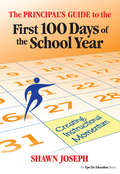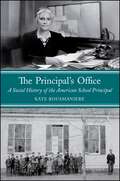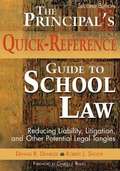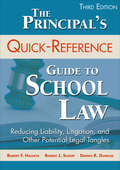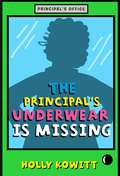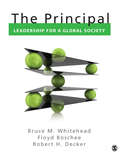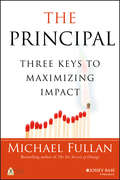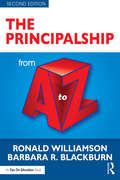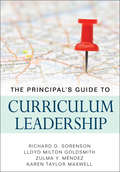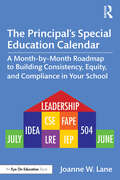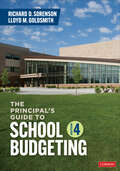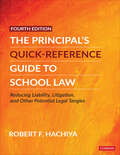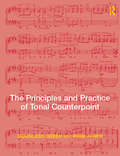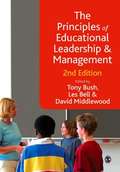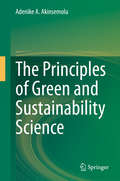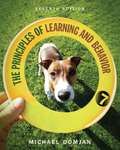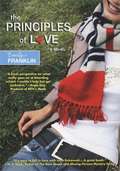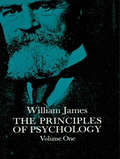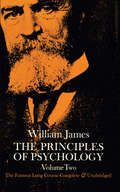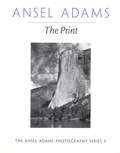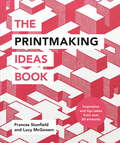- Table View
- List View
The Principal's Guide to the First 100 Days of the School Year: Creating Instructional Momentum
by Shawn JosephFor veteran principals, new principals, and aspiring principals, this book is a valuable resource for building instructional momentum during the beginning of the school year. Educational leadership expert Shawn Joseph guides administrators through five key areas: Vision Instructional Leadership Politics Data Planning With detailed timelines, practical advice, and ready-to-use resources, Joseph explains the essential steps to leadership success that will continue throughout the school year. Supplemental Downloads available to book-buyers!
The Principal's Office: A Social History of the American School Principal
by Kate RousmaniereThe Principal's Office is the first historical examination of one of the most important figures in American education. Originating as a head teacher in the nineteenth century and evolving into the role of contemporary educational leader, the school principal has played a central part in the development of American public education. A local leader who not only manages the daily needs of the school but also represents district and state officials, the school principal is the connecting hinge between classroom practice and educational policy. Kate Rousmaniere explores the cultural, economic, and political pressures that have impacted school leadership over time and considers professionalization, the experiences of women and people of color, and progressive community initiatives. She discusses the intersections between the role of the school principal with larger movements for civil rights, parental and community activism, and education reform. The school principal emerges as a dynamic character in the center of the educational enterprise, ever maneuvering between multiple constituencies, responding to technical and bureaucratic demands, and enacting different leadership strategies. By focusing on the historic development of school leadership, this book provides insights into the possibilities of school improvement for contemporary school leaders and reformers.
The Principal's Quick-Reference Guide to School Law: Reducing Liability Litigation and Other Potential Legal Tangles (2nd Edition)
by Dennis R. Dunklee Robert J. ShoopOffering a resource on translating school law into practice, this title is useful as a day-to-day reference guide of school law in modern times. It helps school administrators find important legal guidance for issues that include: staff selection and evaluation; student rights and discipline; and more.
The Principal's Quick-Reference Guide to School Law: Reducing Liability, Litigation, and Other Potential Legal Tangles
by Dennis R. Dunklee Dr Robert J. Shoop Dr Robert F. HachiyaThe go-to legal resource for principals, fully updated! How often does a potential legal issue arise at your school? Now in an expanded third edition, this trusted resource provides clear and helpful guidance from a team of respected school-law experts. Substantive new information shows principals how to: Address student use and misuse of technology, on and off campus Avoid the pitfalls of zero-tolerance discipline policies Lead school safety and violence prevention, including collaboration with school resource officers and other personnel Prevent and respond to bullying incidents Stay current with special education requirements Ensure that employment and evaluation practices reflect the law
The Principal's Underwear Is Missing
by Holly KowittWhen you're a sixth-grade nobody, the last person you want to accidentally zonk with a volleyball is Sloan "Selfie" St. Clair--the eighth-grade glamour queen of the school. But that's what happens to Becca Birnbaum, and it only gets worse when she tries to do Selfie a favor. She grabs the wrong shopping bag from the principal's office -- one containing a very personal item. and even that might not be so bad, if only Selfie didn't immediately lose it. If they don't get it back ASAP, they're toast. They try not to panic--until they hear that the Biggest Prank Ever is about to happen. Can the school's oddest couple stop the disaster of a lifetime?
The Principal: Leadership for a Global Society
by Bruce M. Whitehead Floyd A. Boschee Robert H. DeckerThe path to becoming a leader for your students, faculty, and community begins here.The Principal: Leadership for a Global Society is the core textbook for aspiring and practicing K-12 school principals. Taking a practical and research-grounded approach, this inspiring text prepares school leaders to successfully face the challenges that they will deal with on a day-to-day basis and throughout their careers. From curriculum development to staff development to policy and discipline, it addresses the most up-to-date practices in developing leadership skills. The book provides a wide array of pedagogical features to help practicing and aspiring school principals improve programs, create a safer and more enriching environment for students and faculty; meet school, district, community, state, and national ideologies and standards; and much more. After reading The Principal, the educational leaders of tomorrow will be equipped with innovative, practical, and successful leadership concepts and ideas that will help them make a powerful impact on not just those who walk through the school doors, but the community as well.
The Principal: Three Keys to Maximizing Impact
by Michael FullanThe author of Six Secrets of Change describes how and why the principal's role must change to maximize student achievementPrincipals are often called the second most crucial in-school influencers (after teachers) of student learning. But what should the principal do in order to maximize student achievement? One of the best-known leadership authors in education, Fullan explains why the answer lies neither in micro-managing instruction nor in autonomous entrepreneurialism. He shows systematically how the principal's role should change, demonstrating how it can be done in short order, at scale.Reveals the three key roles that administrators must play in today's schoolsExplains how to choose the right versus wrong drivers of school successFilled with "action items" to help implement Fullan's program effectivelyIncludes strategies that have been successfully field-tested in schools across the United States and Canada
The Principalship from A to Z (A to Z Series)
by Ronald Williamson Barbara R. BlackburnThe second edition of The Principalship from A to Z provides a set of tools that can be used immediately to improve your leadership practice. Organized into 26 chapters—one for each letter of the alphabet—this book covers the most important and prevalent issues and skills for leaders in today’s schools, including matters of limited funding, juggling social media, teacher evaluation, student achievement, school safety, and collaborating with parents. This accessible guide offers specific strategies that will help you navigate the complexity of your job and help you to become a more effective principal. Topics new to this updated edition include: A renewed focus on student learning as the first priority of a principal and updated strategies for becoming a powerful instructional coach Information about restorative justice practices and other disciplinary approaches Timely new chapters on motivating teachers and students, using social media, and handling limited resources Updated resources at the end of each chapter For both new and experienced leaders, you’ll find this book to be full of practical templates and strategies to implement immediately. Many tools are available as free eResources from our website, www.routledge.com/9781138899568.
The Principal’s Guide to Curriculum Leadership
by Richard D. Sorenson Lloyd M. Goldsmith Zulma Y. Mendez Karen T. MaxwellPractical guidance for spearheading curriculum development and change This comprehensive guide walks principals through the curriculum development and renewal process with encouragement, hitting the hard issues of doing more with less, integrating technology, creating a culture of improvement, and improving student outcomes. The authors incorporate the Interstate School Leaders Licensure Consortium (ISLLC) and the Educational Leadership Constituent Council (ELCC) standards for principals as they relate to curriculum leadership. Highlights include step-by-step guidance for: Working collaboratively with personnel Integrating state and national standards into school curriculum Maximizing professional development opportunities Connecting curriculum to instruction
The Principal’s Special Education Calendar: A Month-by-Month Roadmap to Building Consistency, Equity, and Compliance in Your School
by Joanne W. LaneThe Principal’s Special Education Calendar is a pragmatic, “do-now” guide that addresses a building leader’s special education responsibilities over the course of the school year.Developed for novice and experienced principals, it also meets the needs of professors and aspiring principal candidates looking for a resource to bridge theoretical approaches with the practical aspects of the job.Based on quarterly marking periods for ease of planning and organization, this book provides a comprehensive guide for principals. It includes real-life scenarios, legal red flags, must-have resources to illustrate, “Why this is important,” and key monthly tasks with concluding checklists that recap the top action items for follow-up – all in a conversational, easy-to-read format. With a focus on what information principals need to know, when to know it, and why, this book is the ultimate hands-on special education guide for principals everywhere to build compliance and fill in the gaps left bare in preparation programs.
The Principal′s Guide to School Budgeting
by Richard D. Sorenson Lloyd M. GoldsmithAlign your school budget with your vision for student achievement Since 2006, The Principal′s Guide to School Budgeting has been a best-seller, supporting thousands of principals in navigating the complex process of school budgeting. This fourth edition hones in on the message that a school budget should be a reflection of the school’s vision for student growth, an open culture, and a positive school climate. This edition offers new information on how national and state reform and political practices affect school allocations and emphasizes the need for appropriate budget visioning, planning, analysis, and needs assessment. Covering the budgeting process, effective budgeting practices, accounting and auditing procedures, and building the school budget within a collaborative decision-making context, this comprehensive guide includes: In-chapter vignettes and discussion questions Case study applications and experiential exercises A budget development project New discussion of technology′s impact on budgetary practices, phishing scams, and fundraising The Principal′s Guide to School Budgeting is an essential resource for practicing and aspiring school administrators who want to master their accounting and auditing procedures. By effectively managing the school budgeting process, principals can contribute to improved student achievement and strengthen connections with the school community.
The Principal′s Guide to School Budgeting
by Richard D. Sorenson Lloyd M. GoldsmithAlign your school budget with your vision for student achievement Since 2006, The Principal′s Guide to School Budgeting has been a best-seller, supporting thousands of principals in navigating the complex process of school budgeting. This fourth edition hones in on the message that a school budget should be a reflection of the school’s vision for student growth, an open culture, and a positive school climate. This edition offers new information on how national and state reform and political practices affect school allocations and emphasizes the need for appropriate budget visioning, planning, analysis, and needs assessment. Covering the budgeting process, effective budgeting practices, accounting and auditing procedures, and building the school budget within a collaborative decision-making context, this comprehensive guide includes: In-chapter vignettes and discussion questions Case study applications and experiential exercises A budget development project New discussion of technology′s impact on budgetary practices, phishing scams, and fundraising The Principal′s Guide to School Budgeting is an essential resource for practicing and aspiring school administrators who want to master their accounting and auditing procedures. By effectively managing the school budgeting process, principals can contribute to improved student achievement and strengthen connections with the school community.
The Principal′s Guide to Time Management: Instructional Leadership in the Digital Age
by Richard D. Sorenson Lloyd M. Goldsmith David E. DeMatthewsMake the most of your time—and your leadership Is your school’s vision getting buried under paperwork? Are goals constantly pushed aside for small emergencies? If you spend more time picking up pieces than putting them together, this is your book. Written by seasoned school principals, this plan of action will get you back to the instructional leadership that made you want this job in the first place. As educational technology helps you maximize your efficiency, you’ll see improvement where it counts—in teaching, student achievement, morale, and resource management. This comprehensive guide features: Easy-to-follow, single-topic chapters Standards–based scenarios and questions Time management self-assessments Easily adaptable experiential exercises Strategies for battling the "silent time thief" Tailor-made for overworked administrators just like you, you’ll become the leader you want to be—and promote a positive school culture where teachers and students thrive. "The authors have lived the demanding schedule as school leaders. They provide real advice on how to keep the balance with the demands of school leadership and to give the gift of time to family and self." -Dr. Tricia Peña, Professor Northern Arizona University "This book should be a must read for every practicing or aspiring administrator. The authors take a fresh look at time management issues while maintaining a focus on principles of effective leadership and applications of emerging technology." -Chris Hubbuch, Principal Excelsior Springs Middle School, MO
The Principal′s Guide to Time Management: Instructional Leadership in the Digital Age
by Richard D. Sorenson Lloyd M. Goldsmith David E. DeMatthewsMake the most of your time—and your leadership Is your school’s vision getting buried under paperwork? Are goals constantly pushed aside for small emergencies? If you spend more time picking up pieces than putting them together, this is your book. Written by seasoned school principals, this plan of action will get you back to the instructional leadership that made you want this job in the first place. As educational technology helps you maximize your efficiency, you’ll see improvement where it counts—in teaching, student achievement, morale, and resource management. This comprehensive guide features: Easy-to-follow, single-topic chapters Standards–based scenarios and questions Time management self-assessments Easily adaptable experiential exercises Strategies for battling the "silent time thief" Tailor-made for overworked administrators just like you, you’ll become the leader you want to be—and promote a positive school culture where teachers and students thrive. "The authors have lived the demanding schedule as school leaders. They provide real advice on how to keep the balance with the demands of school leadership and to give the gift of time to family and self." -Dr. Tricia Peña, Professor Northern Arizona University "This book should be a must read for every practicing or aspiring administrator. The authors take a fresh look at time management issues while maintaining a focus on principles of effective leadership and applications of emerging technology." -Chris Hubbuch, Principal Excelsior Springs Middle School, MO
The Principal′s Quick-Reference Guide to School Law: Reducing Liability, Litigation, and Other Potential Legal Tangles
by Robert F. HachiyaThe go-to legal resource for today’s principals! New technology and world events have upended everything we once took for granted about schools, including the laws and policies that govern them. School safety concerns, curriculum challenges, the ever-changing landscape of social media, and the 2020/2021 COVID-19 crisis have made school leadership an infinitely more complex arena. Familiarity with the law is essential to help principals maintain safe and equitable communities and minimize legal risk. The 4th edition of The Principal′s Quick-Reference Guide to School Law provides the go-to help principals need to increase their knowledge of education law in this time of change. Within its pages, leaders can access tools to help them make better decisions when educational law related issues impact their schools. Readers will find A completely revamped design for easier reference Practical examples to help demystify complex cases Updated cases studies from 2014 to today Guidance on new topics, such as vaping, sexting, student protests and walkouts An "Education Law 101 for Teachers" section to help leaders provide basic legal training for staff and teachers. Written for aspiring and current school principals, this book will answer all the “what if” questions that inevitably arise at least once in every leader’s tenure.
The Principal′s Quick-Reference Guide to School Law: Reducing Liability, Litigation, and Other Potential Legal Tangles
by Robert F. HachiyaThe go-to legal resource for today’s principals! New technology and world events have upended everything we once took for granted about schools, including the laws and policies that govern them. School safety concerns, curriculum challenges, the ever-changing landscape of social media, and the 2020/2021 COVID-19 crisis have made school leadership an infinitely more complex arena. Familiarity with the law is essential to help principals maintain safe and equitable communities and minimize legal risk. The 4th edition of The Principal′s Quick-Reference Guide to School Law provides the go-to help principals need to increase their knowledge of education law in this time of change. Within its pages, leaders can access tools to help them make better decisions when educational law related issues impact their schools. Readers will find A completely revamped design for easier reference Practical examples to help demystify complex cases Updated cases studies from 2014 to today Guidance on new topics, such as vaping, sexting, student protests and walkouts An "Education Law 101 for Teachers" section to help leaders provide basic legal training for staff and teachers. Written for aspiring and current school principals, this book will answer all the “what if” questions that inevitably arise at least once in every leader’s tenure.
The Principles and Practice of Tonal Counterpoint
by Evan JonesThe Principles and Practice of Tonal Counterpoint is a comprehensive textbook that combines practical, "how-to" guidance in 18th-century techniques with extensive historical examination of contrapuntal works and genres. Beginning with an introductory grounding in species counterpoint, tonal harmony, and figured bass, students progress through the study of chorale preludes, invertible counterpoint, and canonic and fugal writing. This textbook thoroughly joins principle with practice, providing a truly immersive experience in the study of tonal counterpoint and familiarizing students with contrapuntal styles from the Baroque period to the 21st century. Also available is a companion volume, The Principles and Practice of Modal Counterpoint, which focuses on 16th-century techniques and covers modal music from Gregorian chant through the 17th century.
The Principles of Educational Leadership and Management
by Tony Bush Les Bell David MiddlewoodFully revised and thoroughly updated, this second edition of this classic book brings together many leading international authors on educational leadership, with brand new chapters from leaders in the field Ken Leithwood, Paul Begley, Allan Walker and Alma Harris. Providing an overview of essential topics within the field, this book adopts an international perspective and offers conceptual and empirical insights into: - Moral and ethical leadership - Distributed leadership - Developing leaders - Leadership for learning - Building and leading learning cultures - Managing human and financial resources - Leadership for diversity - Leadership, partnerships and community - Professionalism and professional development The book is for scholars, researchers and postgraduate students in educational leadership, management and administration, as well as for senior leaders in education and those taking professional leadership qualifications.
The Principles of Green and Sustainability Science
by Adenike A. AkinsemoluThis book uses the concept of sustainability in science to address problems afflicting the environment, and to devise measures for improving economies, societies, behaviors, and people. The book pursues a scientific approach, and uses scientific evidence as the basis for achieving sustainability. The key topics addressed include: unemployment, health and disease, unsustainable production, our common future, renewable energies, waste management, environmental ethics, and harmful anthropogenic activities. Whereas past literature has mainly examined sustainability as an environmental issue, this book expands the conversation into various sciences, including mathematics, biology, agriculture, computer science, engineering, and physics, and shows how sustainability could be achieved by uniting these fields. It offers a wealth of information across various disciplines, making it not only an intriguing read but also informative and insightful.
The Principles of Learning and Behavior
by James W. GrauThis learning and behavior textbook provides a comprehensive introduction to the elementary forms of learning that have been the focus of research for much of the 20th century.
The Principles of Love
by Emily FranklinThe Gilmore Girls meets The Sisterhood of the Traveling Pants in this fun, sophisticated teen novel about the lovable Love Bukowski. First in a brand-new series. The "movie version" of Love Bukowski's life is picture perfect. She can roll out of bed and be at class in her new prep school within minutes because she lives in an amazing house on Hadley Hall Campus, where her Dad just happens to be the principal. And though she's just joined the ranks of the nation's future leaders and lushes of America, they've all become her best friends. Gorgeous upperclassmen crowd around her doorstep just to catch a glimpse of her performing her original songs. Life is sweet! Unfortunately, the not-so-glamorous reality of her life is that her Dad is the principal of the this prototypical New England prep school. Friends are hard to come by, and the only guys who come near her front door are the ones she wants to swat away. Not that there's a shortage of Hadley hotties; it's just that the one Love's singled out is an utterly incredible and totally unattainable senior. Now, Love will have to figure out the true meaning of her name to make her reality as awesome as her fantasies.
The Principles of Psychology, Vol. 1
by William JamesVolume 1 of the famous long course, complete and unabridged. Stream of thought, time perception, memory, experimental methods -- these are only some of the concerns of a work that was years ahead of its time and is still valid, interesting and useful. Total in set: 94 figures.
The Principles of Psychology, Vol. 2
by William JamesThis is the first inexpensive edition of the complete Long Course in Principles of Psychology, one of the great classics of modern Western literature and science and the source of the ripest thoughts of America’s most important philosopher. As such, it should not be confused with the many abridgements that omit key sections.The book presents lucid descriptions of human mental activity, with detailed considerations of the stream of thought, consciousness, time perception, memory, imagination, emotions, reason, abnormal phenomena, and similar topics. In its course it takes into account the work of Berkeley, Binet, Bradley, Darwin, Descartes, Fechner, Galton, Green, Helmholtz, Herbart, Hume, Janet, Kant, Lange, Lotze, Locke, Mill, Royce, Schopenhauer, Spinoza, Wundt, and scores of others. It examines contrasting interpretations of mental phenomena, treating introspective analysis, philosophical interpretations, and experimental research.Although the book originally appeared nearly 75 years ago, it remains unsurpassed today as a brilliantly written survey of William James’ timeless view of psychology.
The Print (Ansel Adams Photography Ser. #Vol. 3)
by Ansel Adams Robert BakerThe Print is the third and final book in the seminal Ansel Adams Photography Series. The Print belongs on every photographer's shelf. It covers the entire printmaking process, from designing and furnishing a darkroom and experimenting with your first print, to mastering advanced techniques such as developer modifications, toning, and bleaching, and burning and dodging. This thorough guide is filled with indispensable darkroom techniques and tips. It is an indispensable tool for mastering the complex art of photographic printmaking. Photographs, instuctional line drawings.
The Printmaking Ideas Book
by Frances Stanfield Lucy McGeownWhether you're discovering printmaking for the first time or you're looking for fresh ideas to reinvigorate your practice, you'll find plenty of inspiration in The Printmaking Ideas Book.From traditional methods such as screenprinting, etching and lithography to contemporary techniques such as risography and digital collage, this book is packed with new ideas, methods and tips on every page.Brimming with experimental, arresting and beautiful examples of printmaking from all over the world, it will take your creativity further and awaken new ideas.
